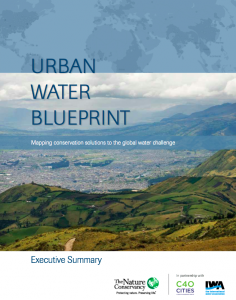More than half of humanity now lives in cities. Large cities alone represent US $21.8 trillion in economic activity, or 48 percent of global GDP. All cities, regardless of size, need a clean, consistent water supply to thrive, so it is little wonder that capital expenditures on water supply are large—US $90 billion per year—and growing. Unfortunately, drinking water sources are increasingly insecure. Cities face twin challenges: water that is both scarce and polluted. Rising demand has been allowed to grow unchecked, competing users upstream do not talk to or trust one another, increasingly unpredictable rainfall patterns have been altered by climate change, and the watersheds where our water comes from have been degraded.
This report is about how investing in nature can help address these challenges. We evaluate one set of solutions to the growing urban water challenge: source watershed conservation. Scientists at The Nature Conservancy (TNC), in partnership with the C40 Cities Climate Leadership Group and International Water Association, present findings on how and where conservation strategies in watersheds can have a material impact on drinking water – drawing on three years of comprehensive, in-depth analysis of the source watersheds that serve over 500 medium and large cities worldwide.


